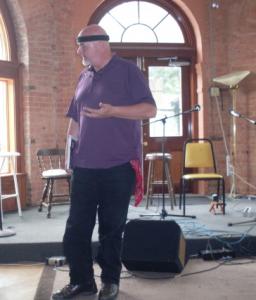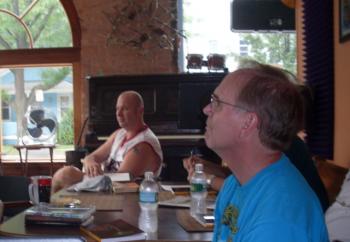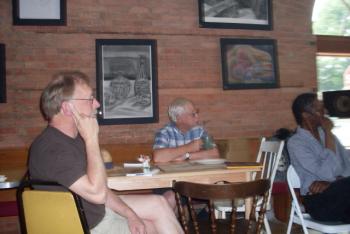Steve Rapson's Workshop on Solo Performance, August 16, 2009

Steve Rapson Makes a Point
Golden Link Folk Society, Rochester Guitar Club and the Mez cosponsored a workshop on Sunday, August 16 from 3 to 5 pm at the Mez on Gregory Street. Steve Rapson’s workshop on Solo Performance based on his book The Art of the Solo Performer was attended by fifteen enthusiastic participants. As the title implies, the subject is relevant to all types of performance including speech, poetry, singing, dance, music, etc. Steve is an eclectic performer with experience as a speaker, solo guitarist, band leader and singer with a repertoire including classical, jazz, folk and a variety of other styles. When his mother was pregnant with him she met Segovia at Symphony Hall in Boston. How could he not become a guitarist?!
Steve had a lot of practical advice to offer based on his own experience focusing on preparation, stage presence and audience contact. He advised us to begin preparation weeks in advance using material that is easy for us. Although easy for us, it may be amazing to the listener! He cited Johnny Cash as an example of a performer with simple, but interesting material. If the piece is too difficult for you, rearrange it or drop it until it becomes easy for you. Choose songs familiar to the audience, only occasionally inserting your own material. Children’s songs and novelty tunes are effective and attract attention from everyone. Steve himself creates lyrics to accompany classical pieces such as Bach’s Bourrée. Borrow material from performers that you admire and use it to your own advantage giving credit where it’s due. Lenny Bruce used his mother’s material in his early performances. Finally, prepare your material thoroughly. Every aspect of the performance should be rehearsed including the entrance, setup and exit.

A Captive Audience
As Steve says, “Go early, Go mingle, Go hide, Go get ‘em!” Have a simple check list of things you need to bring and things you need to do for setup. Arrive early and if an audience is already present, greet them on the way to setting up. Avoid unsure gestures such as fiddling with the mike, wires or other equipment. Don’t test the sound by saying, “testing” or blowing into the mike. Instead, tap the mike lightly and greet the audience as a test. Shaky hands and shallow breathing are signs of nervousness. If sweating is a serious problem for you try a dry crystal deodorant rub on your temples. Just before your performance find a quiet place to be alone and prepare your mind. Close your eyes and meditate taking three slow, deep breaths. This will calm you and lower your heart rate. You needn’t practice your material just before the performance; it’s too late! Bring your instrument to the stage and put it down. Have bits of business to perform.
Begin your performance by playing the first piece before introducing yourself. This will give the audience an idea of what you are about. If you are dissatisfied with something you do, don’t communicate that to the audience. You may have to fake it, possibly repeating your mistake purposely! Louis Armstrong began the practice of scatting when he forgot the lyrics to a song! During your performance connect with the audience. Look into the eyes of the most receptive individuals that you see. The eyes are the windows to the soul. This is not the way we normally behave; so you will have to work at it. Be yourself, but don’t dwell on yourself nor be arrogant nor self absorbed; share your performance with the audience. Be vulnerable on stage; it demonstrates accessibility. Use a variety of dynamics in your performance. It is more interesting!
Once you complete your performance bow deeply to your audience. Move aside if necessary to avoid obstacles. If you want to speak to the audience, begin just before the applause dies away. If you want to do an encore, leave time in the program for it. Once the performance is over, build your connection to your fans and sell your product whether it is a CD or a mailing list. How do you sell your product? Ask people to buy! Greet them as they leave with CD or mailing list in hand. Look them in the eye when you ask.

Ready to Try It Out!
After your performance send a handwritten thank-you note to the person who gave you the job. If you were able to take a video of your performance, watch it after about ten days. Tighten your act based on what you learned; remove what doesn’t work and keep what does. If it works, use it again! Whatever works on stage should be used in future performances including jokes, remarks, gestures, etc.
The workshop participants were keenly interested and asked provocative questions. One common thread was what to do about forgetting material during a performance. If you are memorizing lyrics, memorize images instead of words. The rest of the solution to this is to know the material thoroughly beforehand and be sure it is not too hard for you to perform. It is also a good idea to practice at a slow tempo to thoroughly ingrain each motion. Segovia practiced at about a quarter normal speed as did Mozart. It may also be helpful to learn the end of a song first. That way, we become more secure as we proceed through the piece. People often remember the last thing they hear best. Some of our group were players who want to return to music after a corporate career much as Steve did and found sound advice in their quest to return to the world of music. We all left with a little more self confidence and some practical ideas to try out. Steve went well past the allotted time with us much to our satisfaction. We hope to have a chance to renew our dialogue in the future.
Article & Photos:
—R. Taglieri
For more information on Steve Rapson and his book visit the site Solo Performer.
Share this page: ![]() Facebook
Facebook
![]() Del.icio.us
Del.icio.us
![]() StumbleUpon
StumbleUpon
![]() Digg
Digg
![]() Reddit
Reddit
Home ::
About Us ::
Events ::
Articles ::
Resources ::
Contact Us ::
Links
©2007-2008, Rochester Guitar Club, All Rights Reserved, This page last updated 2010-02-27 11:28:46
Website by Red Beagle Web Development.








